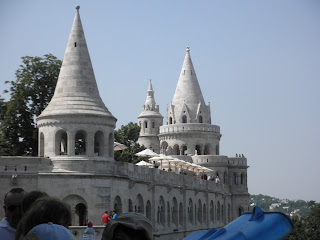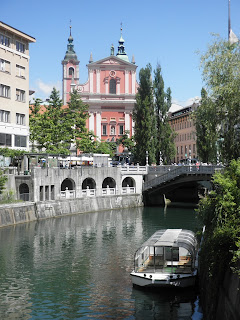By now, we’ve been through tons of formerly Communist countries. We’ve seen the architecture and heard a couple stories. I remember our host in Bulgaria, Polly, told us how there was no place to buy Legos when she was growing up except one that only accepted US dollars. She told us how her grandfather, a pediatrician, saw a Greek patient who paid him in US dollars, allowing him to buy her a Lego set. Other than that, though, we have hardly seen any cases where the societies we have visited publicly addressed their Communist pasts. Budapest changed that, offering us an opportunity to see what Communism and Soviet occupation were like in Hungary.
One of the main historical museums in Budapest is the House of Terror. The museum tells the story of two successive occupations, first by the Nazis and then by the Soviets. It is housed in the building that first hosted the Nazi/Arrowcross (the Hungarian Nazi Party) secret police, and then hosted the Soviet secret police. We were told that many of the latter were simply hold-overs from the former who had been forced to sign a paper saying how they had made a mistake and were ready to serve the Soviet Party. Others were not so lucky – Germans in Hungary, Hungarians with German-sounding names and then plain old Hungarians were carted away to Soviet labor camps. The museum told of how people who climbed the ranks in the Soviet Party were almost uniformly eventually executed by their own party members on trumped-up charges. At all points, I was struck about how open the information was, not only portraying Hungarians as victims but also as participators.
Most strikingly, the last room in the museum condemned those who had participated in creating the terror that haunted Hungarians throughout both of these regimes, saying that neither their lives before or since these atrocities can excuse them. Going further, this room had their names and pictures plastered all over the wall, each with the year they were born and many with the year they died. Others, the pictures reminded us, are still around. At every step, the museum was very artfully curated, leading us sometimes into darkish rooms with gloomy music, into rooms with terrifying video footage and eventually into the basement where prisoners were held. It was effective – I think Tim and I both were scared being in there and it took us both some time to recuperate once we left. We don't have any pictures, but this video actually both shows pictures and summarizes the museum really well.
The following day we went to another, much more lighthearted, display of Communist history: Memento Park. This park was formed in the 1990s after Hungary ceased to be communist and decided that it didn’t really want all of its Communist statues sitting around as a constant reminder of the history. They moved a bunch of memorable statues to a park a bit out of the center city, which has now become quite the tourist destination. We lost no time in having fun with the statues, Tim looking rather heroic and me looking rather cheesy:


It was clear we weren’t alone in making fun of these statues a bit, and I’m not only talking about other visitors. Hungarians seemed to have had a ball making fun of statues like the one above, who they joked was a cloakroom attendant, running after someone to say “Sir! You forgot your scarf!” Another example of people making fun of statues happened when someone hung a sign around the statue below that said something like “Stop smirking, Lenin – after 150 years we’re not Turks either.” The sign was referring to the 150 years of Turkish occupation that had happened centuries before.

A further mockery of the same statue is below in a sign we found in the park:

Just before leaving the park, we also came upon a super interesting exhibition. It was playing a video, a documentary about Soviet secret police. The beginning of the documentary said that it had come upon several video clips in a secret office, videos that were made by the police organization detailing how to raid a home, how to keep watch on someone with the help of secret cameras, how to craft boxes out of inconspicuous objects in order to send secret messages, how to efficiently use blackmail in order to recruit someone into the secret police, etc. It was actually hilarious, though we doubted it was supposed to be. On the other hand, we were struck by how utterly paranoid these people must have been.
To decompress from all this learning about Communism, we paid a visit to the Szechenyi Baths, one of Budapest’s many thermal mineral baths that are still up and running. It was actually pretty relaxing, and though I didn’t dare take my camera out (in addition to there being water everywhere, it was also raining outside), it was very pretty and clearly very old. Apparently Hungary has natural spring water that at points comes out as hot as 77 degrees Celsius!! That’s really hot, when 38 C is a blazingly hot day and 100 C is when water boils. Older Hungarians, we’ve been told, commonly get prescriptions to go to the baths as treatment for joint pain. Sounds pretty relaxing to me.
Ok, I’ll stop there for now. Stay tuned to hear about Bull’s Blood in Eger!


















































